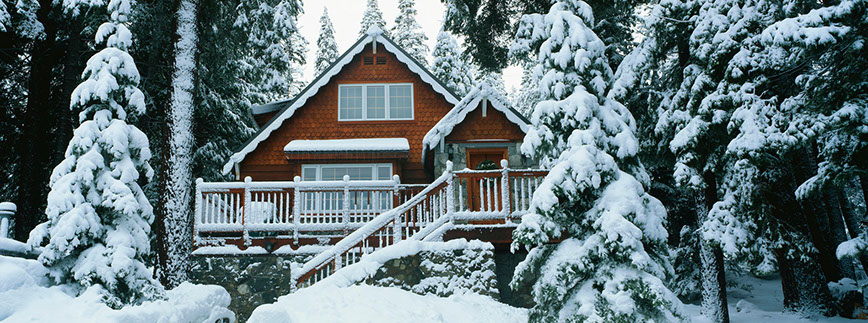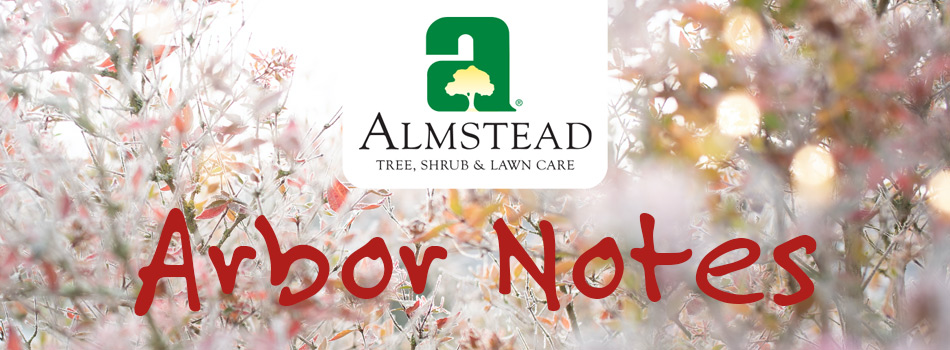The science of preserving nature since 1964
Winter Checklist for Your Landscape

Winter is one of the most important seasons to care for your trees. This is because cold weather and falling snow can damage your trees and shrubs. Here’s a checklist to keep your trees and property safe during the winter months.
Have an Arborist Inspect Your Landscape
 Your Almstead arborist may have inspected your property recently if you took advantage of our complimentary Fall Seasonal Inspection. If you did not schedule an inspection yet, please contact your Almstead branch office — especially if you feel there are issues on your property that need to be addressed. Your arborist will look for weakened, broken, or rotting branches which may not be strong enough to withstand the added weight of a heavy snowfall or ice storm.
Your Almstead arborist may have inspected your property recently if you took advantage of our complimentary Fall Seasonal Inspection. If you did not schedule an inspection yet, please contact your Almstead branch office — especially if you feel there are issues on your property that need to be addressed. Your arborist will look for weakened, broken, or rotting branches which may not be strong enough to withstand the added weight of a heavy snowfall or ice storm.
Prune Your Deciduous Trees
 Winter is a good time to prune your trees for several reasons. The leaves of deciduous trees drop in winter so we can see the structure of the tree better, allowing us to identify weak, cracked and crossing branches. Also when the ground is frozen, we can typically move our trucks and equipment closer to the tree without harming lawns or herbaceous perennials and annuals. And finally, you can take advantage of our winter pruning rates — ask your arborist about about pruning between December and February.
Winter is a good time to prune your trees for several reasons. The leaves of deciduous trees drop in winter so we can see the structure of the tree better, allowing us to identify weak, cracked and crossing branches. Also when the ground is frozen, we can typically move our trucks and equipment closer to the tree without harming lawns or herbaceous perennials and annuals. And finally, you can take advantage of our winter pruning rates — ask your arborist about about pruning between December and February.
Add Mulch for Added Protection
 Young trees and shrubs can benefit from an added layer of protection in winter. The repeated freezing and thawing can push a plant’s shallow roots closer to the surface. Almstead produces high-quality, nutrient-dense mulch that serves as a winter blanket for the plants’ root systems, helping insulate soil from temperature fluctuations while also conserving soil moisture and controlling weeds.
Young trees and shrubs can benefit from an added layer of protection in winter. The repeated freezing and thawing can push a plant’s shallow roots closer to the surface. Almstead produces high-quality, nutrient-dense mulch that serves as a winter blanket for the plants’ root systems, helping insulate soil from temperature fluctuations while also conserving soil moisture and controlling weeds.
Protect Your Evergreens
 Winter can be harsh on trees and shrubs in our area. When the weather is very cold and the ground freezes, plants are unable to absorb water from the surrounding soil. So, instead, they use up the water stored in their leaves and stems. This can be very damaging for evergreens, which retain their leaves in winter. An antidesiccant application adds an additional waxy coating to the leaves, keeping the moisture inside. Many evergreens in our area are especially vulnerable to winter damage — particularly holly, rhododendron, cherry laurel, skip laurel, mountain laurel, Japanese skimmia, leucothoe, aucuba and boxwood. We recommend using an antidesiccant on these plants in early winter, and another application in late-January to mid-February if the weather breaks. The actual “winter” burn becomes evident as temperatures rise in early spring — especially in new evergreen plantings for the first 3 seasons until established.
Winter can be harsh on trees and shrubs in our area. When the weather is very cold and the ground freezes, plants are unable to absorb water from the surrounding soil. So, instead, they use up the water stored in their leaves and stems. This can be very damaging for evergreens, which retain their leaves in winter. An antidesiccant application adds an additional waxy coating to the leaves, keeping the moisture inside. Many evergreens in our area are especially vulnerable to winter damage — particularly holly, rhododendron, cherry laurel, skip laurel, mountain laurel, Japanese skimmia, leucothoe, aucuba and boxwood. We recommend using an antidesiccant on these plants in early winter, and another application in late-January to mid-February if the weather breaks. The actual “winter” burn becomes evident as temperatures rise in early spring — especially in new evergreen plantings for the first 3 seasons until established.




LOCATIONS:
Lower Westchester County, NY and New York City
58 Beechwood Ave, New Rochelle, NY 10801
914-576-0193
Upper Westchester (North of I-287)
15 Broadway, Hawthorne, NY 10532
914-741-1510
Fairfield County, Connecticut
547 Hope Street, Stamford CT 06907
203-348-4111
Bergen & Passaic Counties, NJ
504 High Mountain Road, North Haledon, NJ 07508
973-636-6711
Contact us for a Free Consultation
